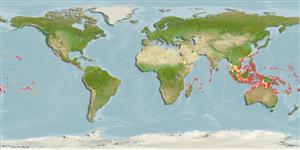Actinopterygii (ray-finned fishes) >
Anguilliformes (Eels and morays) >
Congridae (Conger and garden eels) > Heterocongrinae
Etymology: Heteroconger: Greek, heteros = other + Latin, conger = conger (Ref. 45335).
Environment / Climate / Range
Ecology
Marine; reef-associated; non-migratory; depth range 5 - 50 m (Ref. 90102). Tropical, preferred ?; 30°N - 23°S
Indo-Pacific: Red Sea and East Africa to the Society Islands, north to the Ryukyu and the Ogasawara islands, south to northwestern Australia and New Caledonia; throughout Micronesia (Ref. 1602).
Size / Weight / Age
Maturity: Lm ? range ? - ? cm
Max length : 40.0 cm TL male/unsexed; (Ref. 30874)
Dorsal
spines
(total): 0;
Dorsal
soft rays
(total): 449-540;
Anal
spines: 0;
Anal
soft rays: 273 - 334;
Vertebrae: 163 - 177. Variable but usually two large black spots are obvious; body diameter to about 14 mm (Ref. 48635). Anterior nostrils included in continuous free labial flange. Pectoral fins minute. Total vertebrae 163-177, anal origin below vertebra 59-66.
Often found on sandy slopes below 15 m; withdraws into its burrow when approached. Usually in colonies containing up to several hundred individuals. Feeds on zooplanktons (Ref. 89972).
Life cycle and mating behavior
Maturity | Reproduction | Spawning | Eggs | Fecundity | Larvae
Randall, J.E., G.R. Allen and R.C. Steene, 1990. Fishes of the Great Barrier Reef and Coral Sea. University of Hawaii Press, Honolulu, Hawaii. 506 p. (Ref. 2334)
IUCN Red List Status (Ref. 115185)
CITES (Ref. 94142)
Not Evaluated
Threat to humans
Harmless
Human uses
Aquarium: commercial
More information
Common namesSynonymsMetabolismPredatorsEcotoxicologyReproductionMaturitySpawningFecundityEggsEgg development
ReferencesAquacultureAquaculture profileStrainsGeneticsAllele frequenciesHeritabilityDiseasesProcessingMass conversion
Tools
Special reports
Download XML
Internet sources
Estimates of some properties based on models
Phylogenetic diversity index (Ref.
82805): PD
50 = 0.5000 [Uniqueness, from 0.5 = low to 2.0 = high].
Bayesian length-weight: a=0.00102 (0.00046 - 0.00225), b=3.06 (2.88 - 3.24), in cm Total Length, based on all LWR estimates for this body shape (Ref.
93245).
Trophic Level (Ref.
69278): 3.3 ±0.4 se; Based on size and trophs of closest relatives
Resilience (Ref.
69278): Medium, minimum population doubling time 1.4 - 4.4 years (Preliminary K or Fecundity.).
Vulnerability (Ref.
59153): Low to moderate vulnerability (33 of 100) .
